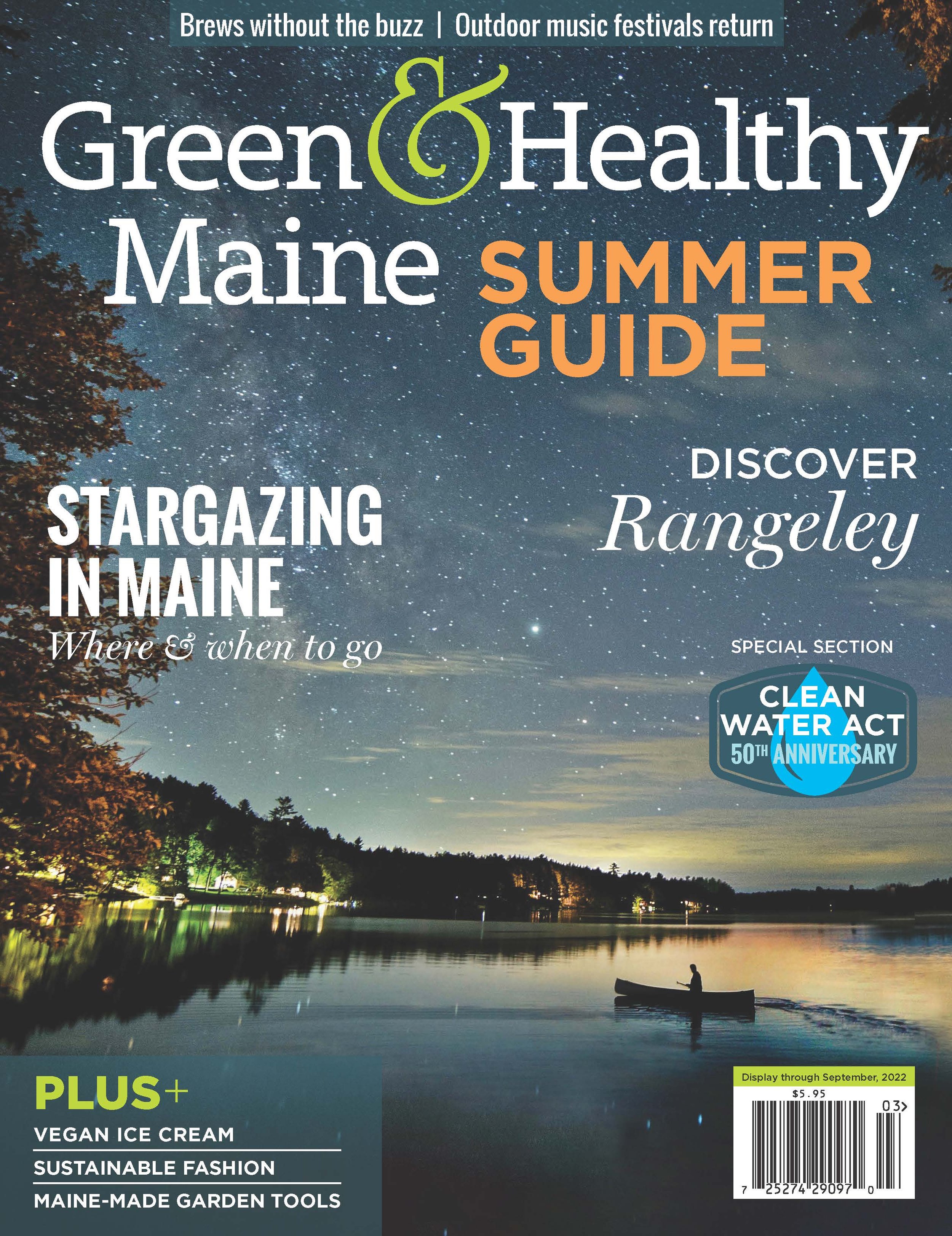River revival: Clean Water Act 50ᵗʰ anniversary
Maine cities turn to face the water
Hot air balloons over the Androscoggin River in Lewiston-Auburn, as part of the annual Great Falls Balloon Festival. Photo: Paul Vanderwerf.
After 50 years of cleanup, Maine cities turn to face the water.
By Andrea Lani
Bangor skyline along the Penobscot River. Photo: Denis Tangney Jr.
FIFTY YEARS AGO ON OCTOBER 18, 1972, the Clean Water Act was signed into law, and Maine has much to celebrate as we mark this milestone.
Maine is a state defined by its waters. More than 7,000 rivers and streams totaling about 45,000 miles run through the state. Around 32,000 lakes, ponds and reservoirs cover more than a million acres, with around 6,000 of those big enough to qualify as lakes or great ponds. The state’s coastline is officially 228 miles long, but when you count every cove and cranny, nearly 3,500 miles of rocky shore and sandy beach meet the North Atlantic’s waters.
With water and wetlands making up around 17% of the state’s area, it’s no wonder a statesman from Maine took the lead in crafting the Clean Water Act to protect and preserve our liquid legacy. Edmund Muskie recognized the link between clean air and water and human health and championed several laws aimed at curbing pollution as Governor of Maine in the 1950s and as chair of the Senate’s Subcommittee on Air and Water Pollution in the 1960s. The years of Muskie’s leadership and vision on this front culminated in the passage of the Clean Water Act in 1972.
The Clean Water Act established ambitious goals for restoring the nation’s waterways. In just over a decade, the aim was to clean waters to a level that could support recreation and aquatic life (the so-called swimmable and fishable standard), and eliminate all pollution discharges two years after that. The act required all facilities within the same industry to treat their wastewater to the same level across the board and also made funds available to upgrade municipal sewage treatment plants. From the Willamette in Oregon to the Potomac in Maryland, rivers across the country have seen vast improvements in water quality thanks to this standardization of requirements, although more work remains to reduce polluted runoff from entering the water.
The Clean Water Act also directed states to classify waters according to desired use and condition. Over the years, Maine has tightened its pollution standards and, as water quality improved, moved certain bodies of water into higher classifications, both reflecting their improvement and further restricting the kinds of activities that could potentially degrade the water.
Lewiston Falls on the Androscoggin River with the city of Lewiston visible in the background. Photo: Jennifer Yakey-Ault.
“Maine has done spectacularly well” implementing the Clean Water Act, according to David Courtemanch, an aquatic biologist and former director of the Division of Environmental Assessment at the Maine Department of Environmental Protection. Nowhere is this success more visible than on Maine’s three big rivers: the Androscoggin, Kennebec and Penobscot. Before the passage of the Clean Water Act, the rivers ran with the effluent from pulp and paper mills, textile factories, tanneries, agriculture, food processing, municipal sewage and log drives. Pollutants caused oxygen levels to dip to near zero in summer months, resulted in closure of clam flats downstream and drove residents away from the water.
By the late 1970s and early ’80s, once the industrial and municipal wastewater treatment systems required by the Clean Water Act came online, water quality in Maine’s rivers began to improve noticeably, according to Courtemanch. Today, 50 years after the passage of the Clean Water Act, not only have these rivers had a remarkable turnaround, but the riverfront cities that once turned their backs to the water have developed new relationships with their rivers, recognizing that they have vital roles to play as central landmarks in the cultural, artistic and recreational opportunities they offer.
Cities turn to face their rivers
There was one surprising benefit of the century of pollution of Maine’s rivers: waterfronts remained largely undeveloped. Towns were situated to face away from the water, and no one outside of industry and the railroads wanted to be on the riverbanks. Because of this, “You can canoe from Waterville to Augusta,” says Courtemanch, “and see maybe a dozen houses.” Clean water has brought new life to these waterfront areas, and many towns and cities along the Androscoggin, Kennebec and Penobscot have created riverside parks, boat launches and walking paths. Let’s take a tour through a few of Maine’s riverfront cities to see how clean water’s comeback has helped open a new chapter for these former industrial centers.
Fort Andross Mill in Brunswick, along the Androscoggin River. Photo: Photo Italia LLC.
Lewiston-Auburn on the Androscoggin
At the time of the Clean Water Act’s passage, the Androscoggin River was considered one of the most polluted in the country, with oxygen levels dropping to near zero in the summer. Situated downstream from pulp and paper mills and other industrial plants, the cities of Lewiston and Auburn bore much of the brunt of the pollution.
This past spring, the state legislature upgraded the portion of the river downstream of Lisbon Falls to the fishable and swimmable standard aimed at by the Clean Water Act, and the river is now home to many fish and wildlife species and is drawing more and more anglers and paddlers. In both Lewiston and Auburn, vibrant downtown redevelopment focuses on the river.
Experience the Androscoggin
Make plans to attend the Great Falls Balloon Festival, held annually in August. Enjoy a parade, food and craft vendors, live music and a rainbow of balloons reflected off the Androscoggin. (Website)
Take a historical tour of downtown Lewiston and Auburn and the Androscoggin River using the Androscoggin Land Trust’s TravelStorys app. Your tour can begin anywhere downtown and is available in both a walking and paddling version.
Memorial Bridge in Augusta over the Kennebec River.
Waterville/Winslow on the Kennebec
Before the passage of the Clean Water Act, low oxygen levels caused fishkills through the mid-20th century. One of the largest sources of pollution was Scott Paper Company in Winslow. The company released direct effluent, as well as bark and sunken logs from the log drives, impeding navigation in the spring and summer. By the late 1970s, after the log drives ended and Scott moved operations to new mills in Fairfield and Skowhegan that had better pulping processes and water treatment technology, water quality improved, fish populations increased, and people began to use the river recreationally again. And in 1999, the hydroelectric Edwards Dam in Augusta was removed, drastically improving water quality in the area and opening 17 miles of river to sea-run fish.
Today, the Kennebec is alive with seasonal runs of river herring, striped bass and smallmouth bass as far as the Lockwood Dam in Waterville. In May and early June, migrating herring draw the largest concentration of bald eagles in the Northeast to the Sebasticook River, from its confluence with the Kennebec at Winslow’s Halifax Park upstream to Benton Falls. Want to get a bird’s eye view of the river’s sparkling waters yourself? Head to downtown Waterville’s newly redesigned Head of Falls Park and the historic Ticonic Footbridge (aka Two Penny Bridge) to Winslow.
Experience the Kennebec
Shop for local produce at the Downtown Waterville Farmers’ Market (Thursdays from the end of April through Thanksgiving, 2–6 p.m.) and enjoy the River Walk at Head of Falls.
Watch the ospreys and eagles enjoy a herring feast or cast your fishing line at Winslow’s Halifax Park. Or get out on the water yourself: launch a canoe at Water Street Boat Landing in Waterville or take a guided drift boat trip from Waterville to Sydney with Three Rivers Guide Service. (Website)
Get creative at Art in the Park at Head of Falls park in Waterville, sponsored by Waterville Creates and Ticonic Gallery + Studios, Thursdays 3–5 p.m., June through August. (Website)
Penobscot River Cribworks.
Bangor/Brewer on the Penobscot
The Penobscot River is Maine’s largest, at over 100 miles long on its main stem. Prior to to the European colonization of North America, the Atlantic salmon run on Penobscot is estimated to have reached as many as 100,000 spawning fish per year. But colonization and industrialization introduced more than 100 dams along the river and its tributaries, preventing salmon and other migratory fish from moving through them. Log drives, paper mills, effluent from other industries and municipal sewage also added to the list of the river’s ills.
But over the last decade, 15 dams have been removed from the Penobscot watershed, including two large dams on the main stem, and fish passage has been added or improved on other dams as part of the Penobscot River Restoration Project. As a result, Atlantic salmon runs have enjoyed largely steady increases. Today, water quality in the entire main stem of the Penobscot is designated swimmable and fishable, a remarkable change, and downtown Bangor and Brewer offer many ways to enjoy the river.
Experience the Penobscot
Get an up-close view of the river on the Penobscot River Paddling Trail. The trail stretches over 100 miles, from Medway to Bucksport, and includes both whitewater and calm stretches. Downloadable and interactive maps provide access and campsite locations, information on river conditions and portages, and links to local accommodations and guide services. (Website)
In the summer months, attend a live concert at Maine Savings Amphitheater at Bangor Waterfront Park. Before the concert, enjoy the waterfront’s walking trails and picnic areas or visit a local restaurant in Bangor’s bustling, revitalized downtown. (Website)
More from the Clean Water Act series
On October 18, 1972, the Clean Water Act was signed into law. With water and wetlands making up around 17% of Maine’s area, it’s no wonder a statesman from Maine took the lead in crafting the Clean Water Act to protect and preserve our liquid legacy. Rivers across the country have seen vast improvements in water quality as a result. Read on for this special series celebrating the 50th anniversary of the Clean Water Act.












After 50 years of cleanup, Maine cities turn to face the water.